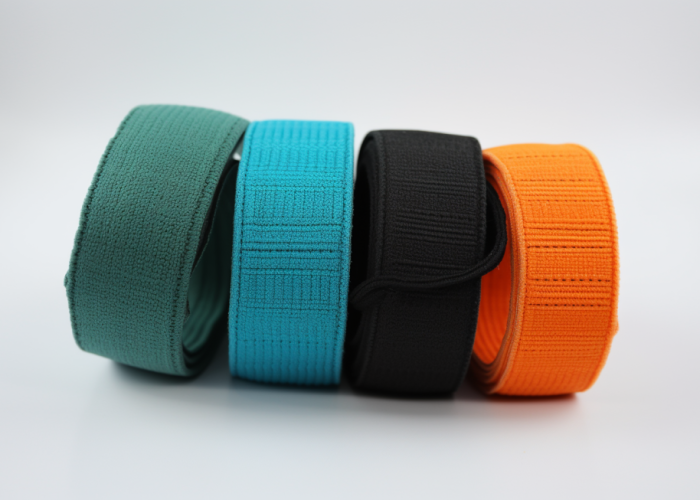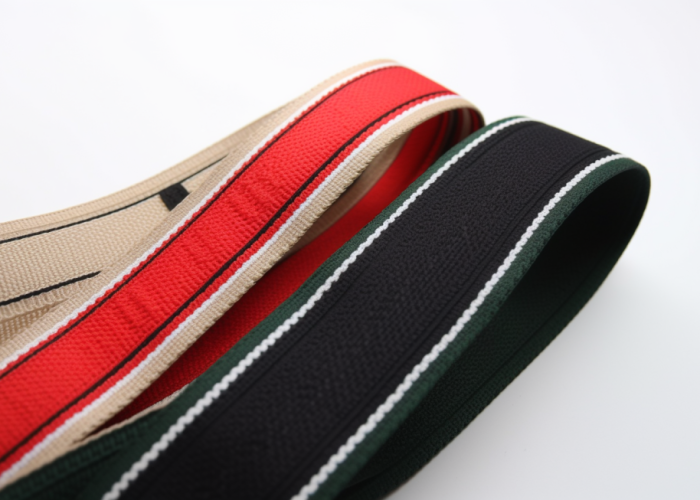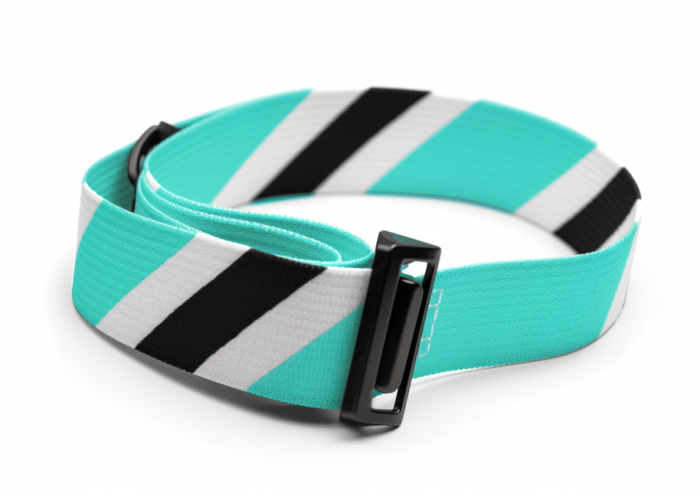Selecting the right elastic material for load-bearing applications requires understanding specific stretch properties and durability factors. As manufacturers with extensive experience producing custom webbing solutions, we’ve analyzed how elastic nylon webbing performs across diverse industrial and consumer applications.
Elastic nylon webbing is a specialized textile material combining the structural properties of nylon with elastic materials to create a flexible, stretchable product that can extend 50-200% of its original length while maintaining recovery strength. This versatile material features interwoven elastic yarns within a nylon structure, providing superior tensile strength, controlled elongation, and resilience ideal for applications requiring both flexibility and durability.
Explore the properties of elastic nylon webbing, compare performance with other materials, and find the best option for safety gear, medical devices, or consumer products based on technical requirements.


Webbing manufacturing expert with 15+ years of experience helping product developers build high-performance straps for industrial, medical, and outdoor use.
Elastic nylon webbing features high tensile strength with 50-200% stretch capacity and excellent recovery properties. This specialized textile combines nylon’s structural integrity with elastic materials, creating a product that maintains shape after repeated stretching while providing superior padding capabilities and even pressure distribution across its surface.
Elastic nylon webbing possesses a distinctive combination of physical properties that make it valuable across industries. The material offers superior padding capabilities due to its elasticity, providing comfort while maintaining structural integrity. This unique combination creates webbing that can compress and stretch while distributing pressure evenly across its surface.
The performance characteristics of elastic nylon webbing particularly shine in dynamic applications. When properly engineered, the material exhibits excellent recovery after stretching, returning to its original form without significant deformation. This resilience is critical for applications like safety harnesses, where maintaining dimensional stability under repeated stress is essential for user protection.
Strength metrics for elastic nylon webbing demonstrate its exceptional durability. The fiber’s natural resilience allows it to absorb energy from sudden impacts, making it ideal for shock-absorption applications. This property, combined with nylon’s inherent strength-to-weight advantage, creates a material that can withstand significant forces while remaining lightweight enough for wearable applications.
Three distinct types of elastic nylon webbing exist: knitted, woven, and braided, each with specific stretch characteristics and application advantages. Knitted webbing offers multi-directional stretch through loop construction, woven webbing provides controlled directional elasticity with elastic threads in warp/weft patterns, and braided webbing creates balanced flexibility with diagonal patterns for specialized applications.
Knitted Elastic Webbing represents the most flexible variant, constructed using loops providing stretch in all directions. This construction method creates a highly adaptable material that conforms readily to irregular shapes. The interlocking loops allow for exceptional elongation while maintaining structural integrity, making it ideal for applications requiring maximum conformability like medical supports and athletic equipment.
Woven Elastic Webbing contains elastic threads running along either warp or weft directions, creating controlled directional stretch. This construction method provides greater dimensional stability than knitted variants while still offering significant elasticity. The woven structure creates a more predictable stretch pattern, making it suitable for applications where controlled elongation is critical, such as safety restraints and industrial strapping.
Braided Elastic Webbing features a diagonal pattern that provides multi-directional flexibility with enhanced structural integrity. The braided construction creates a dense, compact structure that resists abrasion while maintaining elasticity. This design particularly excels in applications requiring a balance between flexibility and durability, such as heavy-duty equipment straps and tactical gear components where reliability under stress is paramount.

Elastic nylon webbing provides 50-200% stretch while maintaining strength characteristics superior to rubber-based elastics and other textile materials. Unlike standard nylon webbing, it offers controlled elongation with excellent recovery, while surpassing rubber-based elastics in UV and chemical resistance, dimensional stability, and load-bearing capacity for industrial applications.
The material’s superior strength-to-weight ratio distinguishes it from alternatives like cotton or polyester elastic materials. While pure nylon webbing offers higher tensile strength, elastic nylon provides the ideal balance between load-bearing capacity and necessary elongation for dynamic applications. This balance makes it particularly valuable in scenarios where both strength and flexibility are critical performance factors.
Environmental resistance comparisons further highlight elastic nylon webbing’s advantages. Unlike natural fiber elastics that deteriorate rapidly in outdoor environments, elastic nylon maintains performance characteristics under challenging weather conditions. It resists moisture absorption better than cotton-based alternatives, preventing weakening and mildew formation during extended exposure to humidity.
Temperature performance comparisons show elastic nylon maintaining functionality across a broader range than many alternatives. While pure rubber elastics become brittle in cold environments and lose tensile strength in heat, elastic nylon webbing maintains operational elasticity across a wider temperature spectrum. This stability makes it more reliable for applications exposed to variable environmental conditions.
Elastic nylon webbing serves critical functions in safety, medical, industrial, and consumer applications where controlled stretch and strength are essential. Key applications include fall protection systems, orthopedic supports, tactical equipment, and consumer products, all benefiting from its unique combination of flexibility, durability, and consistent tension properties.
The medical sector utilizes elastic nylon webbing extensively in orthopedic supports, braces, and rehabilitation equipment. Its ability to provide consistent pressure while allowing anatomical movement makes it ideal for therapeutic applications. The material’s hypoallergenic properties, when properly finished, allow for extended contact with skin without irritation, while its washability maintains hygiene standards for reusable medical devices.
Industrial and military applications leverage elastic nylon webbing’s durability under extreme conditions. Its use in equipment securing straps, parachute systems, and tactical gear demonstrates its reliability when failure is not an option. Manufacturing industries utilize custom elastic webbing for machinery components where standard materials cannot provide the necessary combination of tension and flexibility.
Consumer product applications demonstrate the versatility of elastic nylon webbing across everyday items. From furniture upholstery and luggage components to sporting equipment and automotive accessories, the material provides functional elasticity with superior longevity compared to conventional elastic materials. Its ability to maintain tension through thousands of cycles makes it cost-effective for products requiring long-term performance.

Manufacturing elastic nylon webbing involves creating continuous lengths through specialized equipment combining elastic and nylon components. The production process integrates elastic threads within the nylon structure during weaving, knitting, or braiding operations, with quality control processes ensuring consistent stretch properties, uniform width, and proper tensile strength throughout.
Quality control measures form a critical component of the manufacturing process. Producers implement rigorous testing protocols including elongation testing, recovery assessment, and load-bearing capacity verification. These steps ensure the final product meets precise specifications for performance characteristics, particularly important for applications in safety equipment where material failure could have serious consequences.
Customization options represent a significant advantage in elastic nylon webbing manufacturing. Producers can adjust widths, thicknesses, elasticity ratios, and patterns to meet specific application requirements. Color customization through dyeing processes allows for integration with branded products, while specialized treatments can enhance properties like water resistance, UV protection, or antimicrobial characteristics for specific end-use environments.
Production efficiency continues to evolve with technological advancements in textile manufacturing. Modern equipment allows for increased production speeds while maintaining precision in elastic component integration. These advancements make custom elastic webbing production more accessible for product developers requiring specific performance characteristics without prohibitive minimum order quantities.
Elastic nylon webbing offers superior flexibility, shock absorption, UV resistance, and cost-effectiveness compared to specialized alternatives. Key advantages include significant stretch capability while maintaining shape recovery, resistance to environmental factors, and durability under repeated use, making it ideal for applications requiring both flexibility and strength in challenging environments.
Durability under repeated stretching represents a primary advantage of quality elastic nylon webbing. The material maintains performance characteristics through thousands of stretch cycles, significantly outlasting rubber-based elastics in extended-use applications. This longevity translates to cost savings over product lifecycles, particularly in equipment subject to frequent stress loading.
Cost-effectiveness compared to specialized materials presents a compelling advantage for product developers. Elastic nylon webbing delivers a combination of flexibility and strength that would otherwise require more expensive engineered materials. This accessibility makes it practical for both high-volume manufacturing and specialized, low-volume custom applications where budget constraints exist alongside performance requirements.
Potential limitations include specific environmental vulnerabilities that manufacturers should consider. The material may deteriorate when exposed to certain chemical environments, particularly strong acids and petroleum-based products. Additionally, while offering good UV resistance compared to alternatives, extended exposure to intense sunlight will eventually affect performance characteristics, requiring consideration in outdoor applications with multi-year deployment expectations.

Environmental considerations for elastic nylon webbing focus on manufacturing processes, material sustainability, and end-of-life recyclability options. Production methods vary in energy consumption and chemical usage, with progressive manufacturers implementing water recycling systems, reduced-emission dyeing processes, and waste reduction practices to minimize environmental impact while maintaining product performance.
Manufacturing impact assessment examines energy consumption throughout the production chain. The creation of nylon components requires significant energy input, primarily from petroleum resources. Forward-thinking manufacturers are implementing energy efficiency measures and exploring alternatives to traditional production methods that reduce carbon footprint while maintaining product integrity. These initiatives include equipment upgrades and process optimizations that reduce overall resource consumption.
Recyclability options continue to expand as material science advances. While traditional nylon webbing presents challenges for complete recycling, innovations in material composition are creating more environmentally responsible alternatives. Some manufacturers now offer programs to reclaim used webbing for reprocessing, particularly from large-scale industrial applications where sufficient volume makes collection economically viable.
Ethical production standards increasingly influence purchasing decisions for major brands and product developers. This extends beyond environmental concerns to include labor practices, supply chain transparency, and community impact. Manufacturers adhering to recognized standards like ISO 14001 for environmental management and SA8000 for social accountability offer assurance that elastic webbing production aligns with corporate responsibility objectives increasingly demanded by end consumers.
Elastic nylon webbing delivers the optimal balance of flexibility and strength for demanding applications. Its unique combination of controlled stretch, durability, and customization options makes it an essential component across industries. For product developers seeking reliable performance, elastic nylon webbing provides cost-effective solutions that withstand repeated use while meeting precise technical requirements.
The most common applications include safety harnesses, medical supports, military equipment, furniture suspension, sportswear, luggage components, and automotive systems. Its combination of controlled stretch and strength makes it particularly valuable in applications where failure could compromise safety or product performance.
Elastic nylon webbing typically maintains performance characteristics for 3-5 years in moderate outdoor conditions. UV exposure gradually affects elasticity, with premium formulations offering enhanced resistance. Regular inspection is recommended for safety-critical applications exposed to environmental stressors.
Load capacity varies by width, thickness, and construction method. Properly engineered elastic nylon webbing for safety applications typically supports 1,000-2,500 pounds before failure, with a recommended working load of 25-33% maximum capacity. All safety applications require certified testing to specific industry standards.
Customization options include adjustable width (0.5″-4″), thickness variations, stretch ratios (50-200%), specialized coatings, custom colors, pattern printing, reflective elements, and antimicrobial treatments. Manufacturers can engineer specific performance characteristics for tensile strength, recovery rate, and environmental resistance.
Traditional elastic nylon webbing production has moderate environmental impact due to petroleum-based materials and energy-intensive manufacturing. Progressive manufacturers implement water recycling systems, energy-efficient equipment, and waste reduction practices. Emerging recyclable formulations and take-back programs are improving end-of-life sustainability.
Elastic nylon webbing offers 50-200% stretch capacity with superior recovery compared to alternatives. Unlike rubber elastics that degrade quickly in UV exposure, elastic nylon maintains performance under environmental stress while providing better dimensional stability and load-bearing capacity than cotton or polyester elastics.